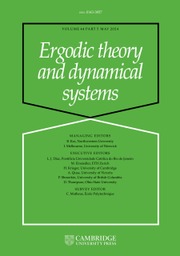No CrossRef data available.
Article contents
Invariant tori for a class of affine Anosov mappings with a quasi-periodic forcing
Published online by Cambridge University Press: 11 September 2025
Abstract
In this paper, we consider a class of affine Anosov mappings with a quasi-periodic forcing and show that there is a unique positive integer m, which only depends on the system, such that the exponential growth rate of the number of invariant tori of degree m is equal to the topological entropy.
MSC classification
Secondary:
37C35: Orbit growth
Information
- Type
- Original Article
- Information
- Copyright
- © The Author(s), 2025. Published by Cambridge University Press
References
Adler, R. L., Konheim, A. G. and McAndrew, M. H.. Topological entropy. Trans. Amer. Math. Soc. 114 (1965), 309–319.10.1090/S0002-9947-1965-0175106-9CrossRefGoogle Scholar
Bowen, R.. Topological entropy and Axiom A. Global Analysis, Berkeley, CA, 1968 (Proceedings of Symposia in Pure Mathematics, XIV–XVI). Ed. S.-S. Chern and S. Smale. American Mathematical Society, Providence, RI, 1968, pp. 23–41.Google Scholar
Bowen, R.. Entropy for group endomorphisms and homogeneous spaces. Trans. Amer. Math. Soc. 153 (1971), 401–414.10.1090/S0002-9947-1971-0274707-XCrossRefGoogle Scholar
Bowen, R.. Periodic points and measures for Axiom A diffeomorphisms. Trans. Amer. Math. Soc. 154 (1971), 377–397.Google Scholar
Bowen, R.. Periodic orbits for hyperbolic flows. Amer. J. Math. 94 (1972), 1–30.CrossRefGoogle Scholar
Huang, W., Lian, Z. and Lu, K.-N.. Dynamical complexity of Anosov systems driven by a quasi-periodic forcing. Sci. China Math. 68(1) (2025), 89–136.CrossRefGoogle Scholar
Katok, A.. Lyapunov exponents, entropy and periodic orbits for diffeomorphisms. Publ. Math. Inst. Hautes Études Sci. 51 (1980), 137–173.10.1007/BF02684777CrossRefGoogle Scholar
Klünger, M.. Periodicity and Sharkovsky’s theorem for random dynamical systems. Stoch. Dyn. 1(3) (2001), 299–338.10.1142/S0219493701000199CrossRefGoogle Scholar
Zhao, H.-Z. and Zheng, Z.-H.. Random periodic solutions of random dynamical systems. J. Differential Equations 246(5) (2009), 2020–2038.10.1016/j.jde.2008.10.011CrossRefGoogle Scholar


